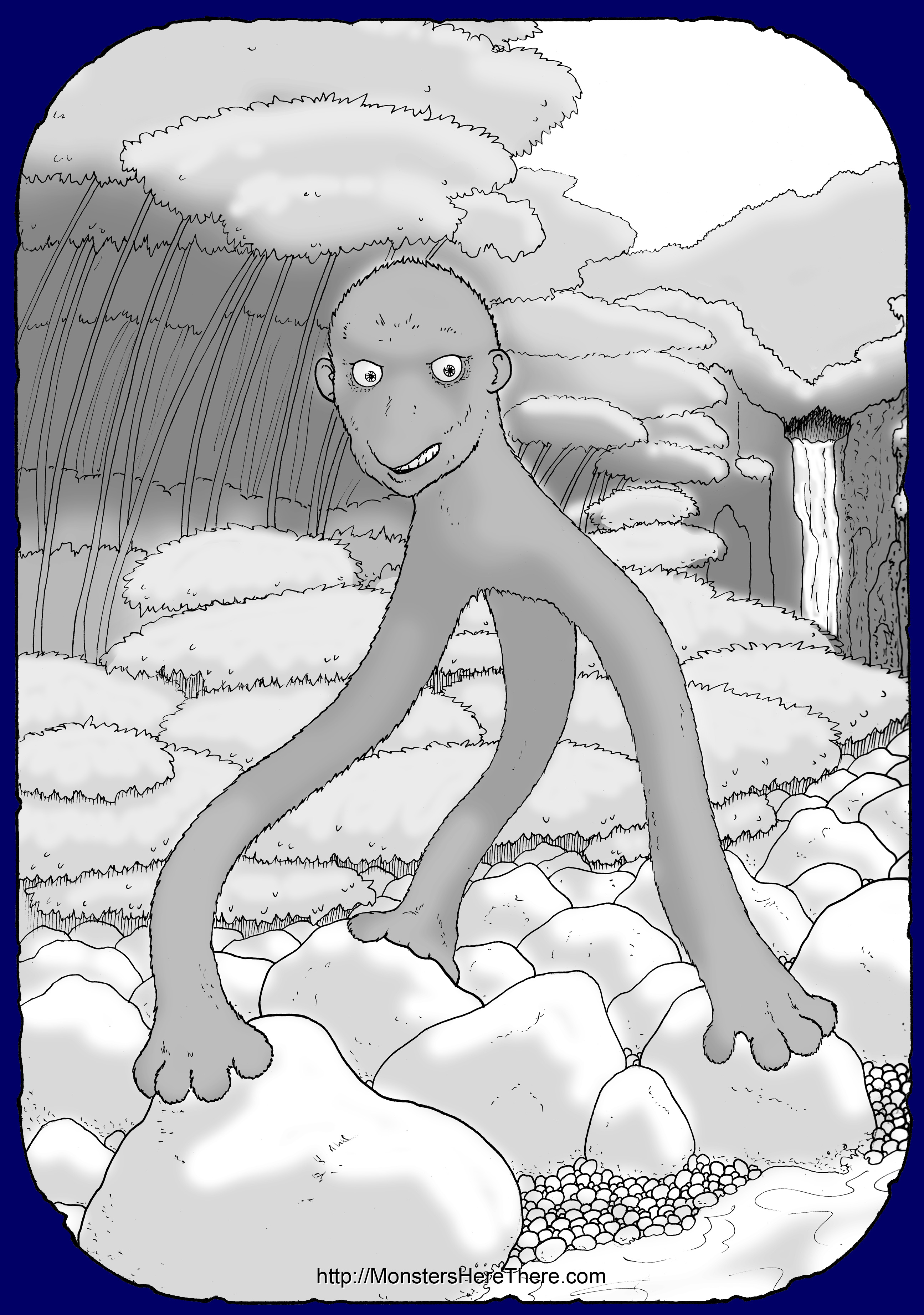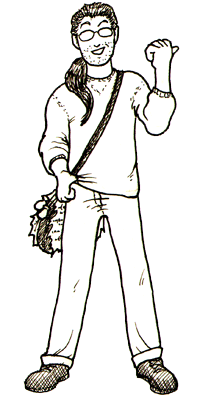Area(s) Reported: Japan
Date(s) Reported: ca. 1603~1876
For at least the past two-hundred years or so, Japan has been host to a small number of strange beings that have been collectively called "Amabiko" [あまびこ]. There are only about nine known reports of these creatures, and each one looks uniquely different from the rest. What these creatures have in common, and the reason they are considered related, are three factors: they stand upright on an unusual number of limbs, they can speak and warn of great disaster coming, and they state that illustrations of themselves can be used to mitigate the bad effects of the coming disasters... and so they encourage people to draw a picture of them, pray over it, and place it at the entrance to their homes to protect against the disasters (including contagious diseases, by the way). Amabiko always appear alone, and it can be decades between appearances. This makes sense, since they only appear at times of great danger. Here are the reports I know of and can find dates for... 1844: Umihiko [海彦] 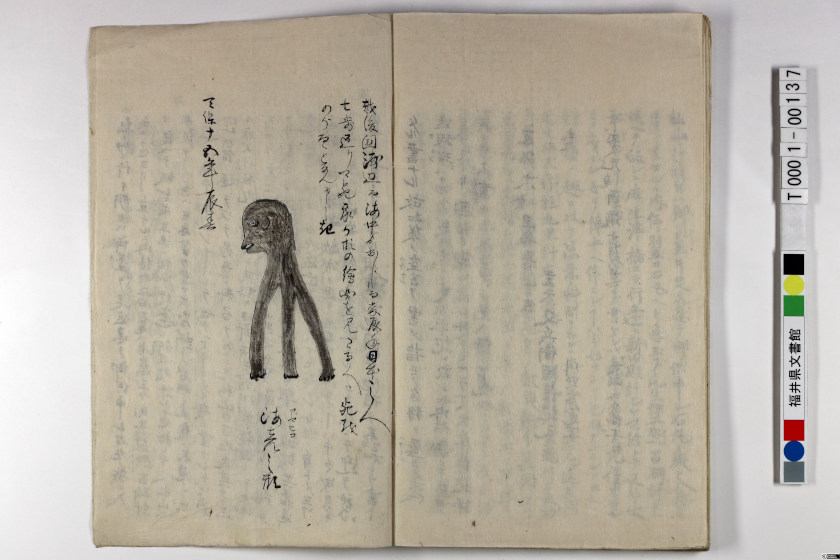
In 1844, a pamphlet was published that described a creature called an "Umihiko", that had appeared in Niigata Prefecture. This creature was basically a head with three hairy legs attached! The Umihiko predicted that no less than 70% of the population of Japan was going to die, unless it's image was distributed to the masses as protection... which is probably why we still have one of those illustrations. 1846: Amabie [アマビエ] 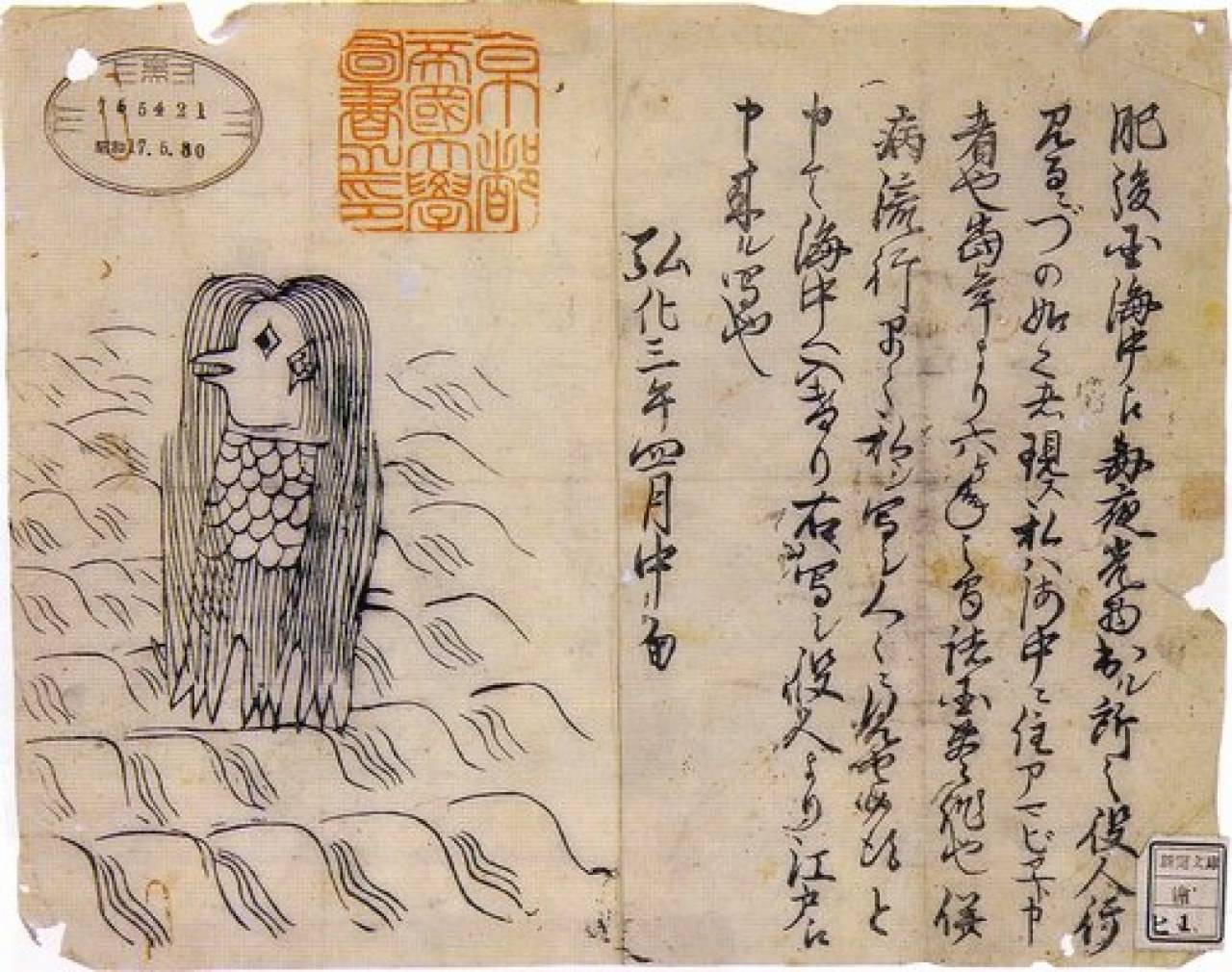
In May, 1846, something strange was seen to be glowing in the ocean each night along the coast of the Kumamoto Prefecture. Eventually, an official was sent to investigate... and a strange fish-like being appeared, standing upon three fins. It spoke, claiming it was an "Amabie," and that for the next six years there would be rich crops throughout Japan; but there would also be plagues throughout the land. 1852: Amabiko [尼彦] 
A man named Hikozaemon Shibata investigated the sound of a monkey that was being heard nightly. He discovered a creature calling itself an "Amabiko" which was illustrated as having a monkey-like face and a short, hairy and round body ending in three feet with claws. This account appears to be false, however, as it specifically claims the creature appeared in Kumamoto Prefecture; but Kumamoto Prefecture was called 'Higo province' back in 1852, only changing names in 1871! 1875: Tenhiko [天日子尊], aka Amahiko no Mikoto 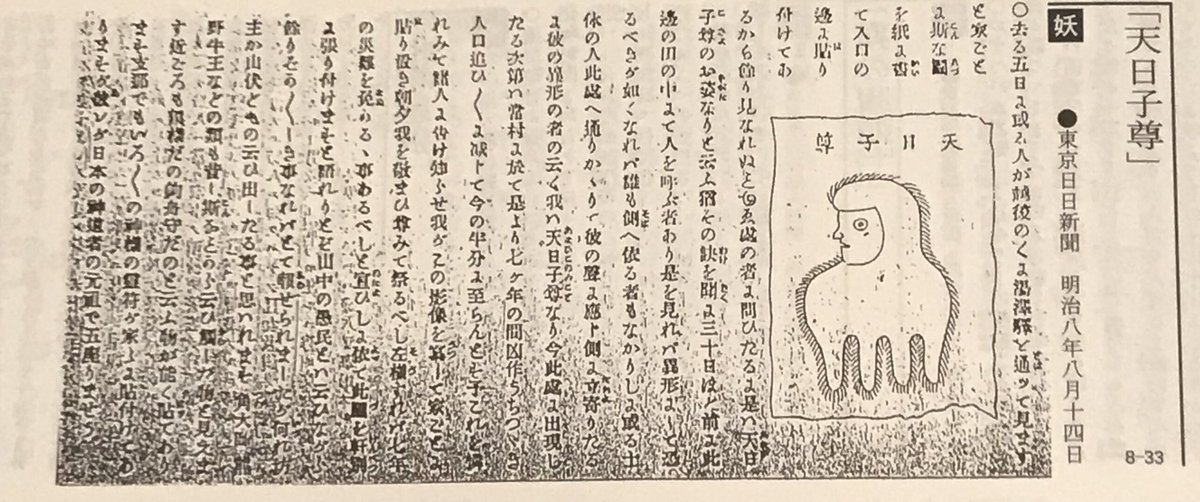
The August 8, 1875, edition of the Nichi-Nichi newspaper in Tokyo announced the appearance of a round bodied creature with four legs and a human face in a rice paddy in Yuzawa, a town in Niigata Prefecture (about 124 miles/200 km from Tokyo), which made predictions of coming disaster. 1876: Arie [アリエ] 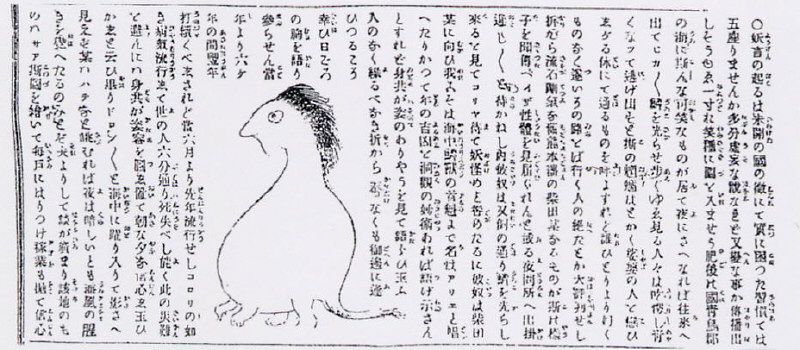
The Nichi-Nichi newspaper of Kofu, in Yamanashi Prefecture, reported on June 17, 1876, that a creature called the 'Arie' came out of the ocean in Kumamoto Prefecture and made predictions. The creature was depicted as a four-legged round animal with a short tail, and a head on a neck with a black mane; then another newspaper quickly pointed out a number of factual errors in the report, leading to the story being labeled a hoax. (Garth note: The name "Nichi-Nichi" essentially means "Every Day"... which is why it's a popular title for newspapers in Japan.) And here's two appearances I don't have a definite date for; they occurred sometime within the "Edo Period"... so sometime between 1603-1868, though more likely in the same time range as the above accounts: Yamaharaha [山童] 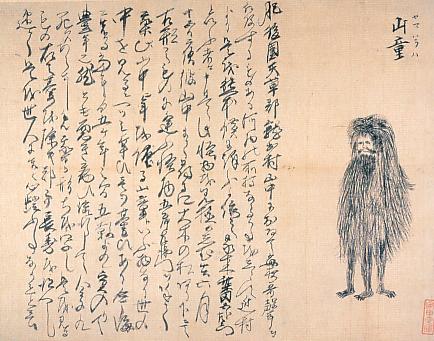
All I have on this particular monster at the moment is one indecipherable image, which shows a hairy, armless man with three legs. This creature is said to have appeared near the village of Amakusa-gun in Kumamoto Prefecture. But I don't know when, or what the creature's prediction was... the text in the image is old, hand-written Japanese, so until I find either a transcription or translation, I don't have much more I can add. Amabiko Nyudo [尼彦入道] 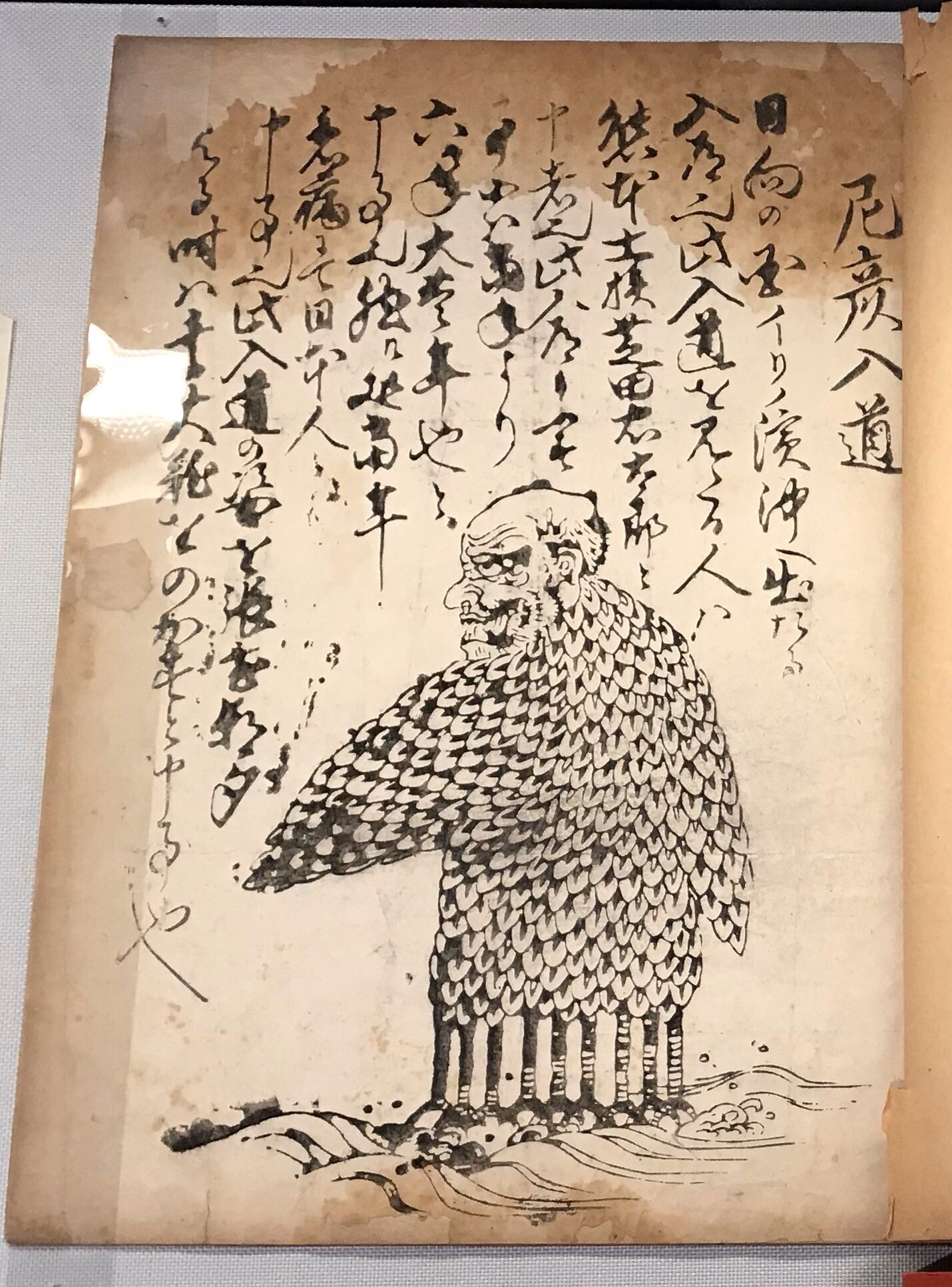
This illustration is in the collection of the Miyoshi Mononoke Museum in Miyoshi, Hiroshima Prefecture, Japan, and the name implies its an "amabiko priest." This creature is said to have appeared off the coast of Irino, in the Miyazaki Prefecture. Like the others, it predicted bountiful harvests and a coming pestilence. While it might sound odd that the mere illustration of a monster could have a positive effect on disasters, it's not entirely a new idea. Japan is also host to the monster known as the Baku, which eats the spirits that cause bad dreams; and the belief that an image of the Baku could scare off these bad spirits and thus prevent bad dreams to begin with has existed since at least the 14th Century. Following the logic, images of Amabiko might simply scare away bad spirits that can cause disasters, thus protecting people who had the illustrations. 2020: The Coronavirus Amabie 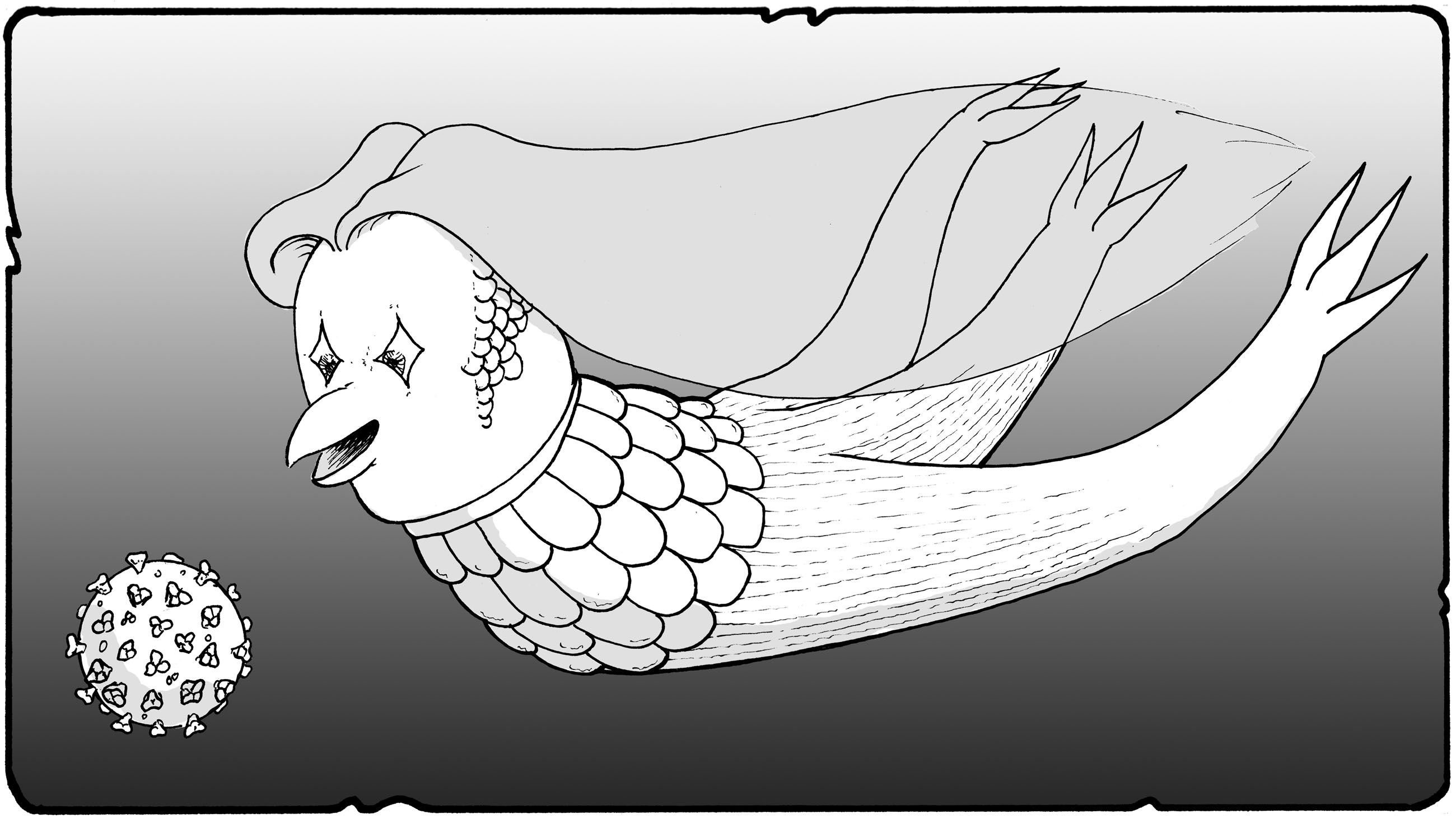
In December of 2019, a new illness started to spread across the world. The first confirmed cases of the 'Coronavirus' -- later labeled as 'Covid-19' -- were in China but, due to the disease's two-week incubation period, it soon spread to other countries in travelers who had no idea they were sick. By March 6, 2020, the coronavirus was a full-blown global pandemic; and people worldwide were scared and worried. Many countries adapted "social distancing" measures to slow the spread of the disease, meaning most people were encouraged to stay home and avoid public exposure as much as possible... and to help encourage this, most public events and gathering spots closed for the duration of the pandemic. One of the places that was closed to public access was the Kyoto University Library in Japan. On March 6, the library posted an apology to its users in the social media website Twitter for the inconvenience. By way of a small treat for its readers -- and to point up how much of the library's collection was actually available online -- they shared one of the more unusual pieces in the collection; the pamphlet shown above of the "Amabie" [アマビエ] that was published in 1846. They explained that the illustration of the monster was considered to be either good luck or protective during times of plague. This proved to be a good choice, for the Amabie -- of all the strange things considered to be Amabiko -- was already the best known, at least to fans of the popular Japanese anime TV franchise GeGeGe no Kitaro ["Kitaro's Creepy Laugh"]. In the show the main character Kitaro solved mysteries and crimes that involved legendary Japanese monsters and ghosts. In the 2007 series of GeGeGe no Kitaro, an Amabie was a repeating character... so it didn't take long for older fans of the show to recognize who was in the post from Kyoto University Library! From there, social media and Japanese artists spread the word... and soon both the old picture and new pictures of the Amabie were appearing on the internet worldwide in the hope it would help stop the pandemic (or at least help people calm down about it!). It was appearing so often, that even official public agencies decided to recruit the monster's help; here's a poster the Japanese health ministry started to distribute in April 2020 to raise awareness: 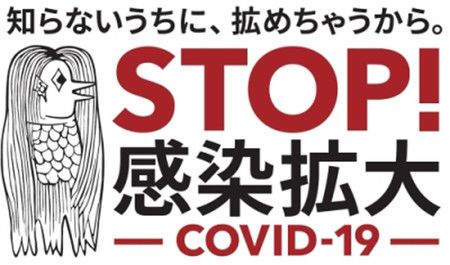
And so an old monster was recast in a new light. But were the Amabiko real to begin with? The similarity in the stories has led researchers to believe that each new 'amabiko' story was just a re-write of the previous stories, with some new 'monster' attached. It would seem that the main question then is whether or not the earliest account was real... or if the reported monster was just a scam to insure lots of people would buy the pamphlet to protect themselves from a vague future disaster. Frankly, I simply hoped all the new Amabie images on the internet would actually help stop the pandemic!
See also: The Baku [獏], Yogen no Tori [ヨゲンノトリ]: The Bird of Prophecy | 